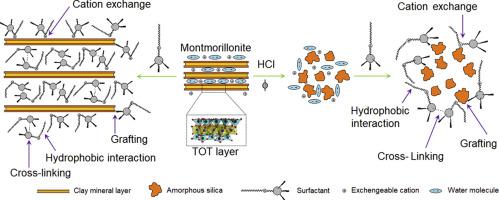当前位置:
X-MOL 学术
›
Appl. Clay. Sci.
›
论文详情
Our official English website, www.x-mol.net, welcomes your feedback! (Note: you will need to create a separate account there.)
Facile modification of montmorillonite by intercalation and grafting: The study of the binding mechanisms of a quaternary alkylammonium surfactant
Applied Clay Science ( IF 5.6 ) Pub Date : 2020-09-01 , DOI: 10.1016/j.clay.2020.105738 Israel G.A. Funes , Marcos E. Peralta , Gisela R. Pettinari , Luciano Carlos , María E. Parolo
Applied Clay Science ( IF 5.6 ) Pub Date : 2020-09-01 , DOI: 10.1016/j.clay.2020.105738 Israel G.A. Funes , Marcos E. Peralta , Gisela R. Pettinari , Luciano Carlos , María E. Parolo

|
Abstract Modified clays are among the most investigated organic-inorganic hybrid materials. Traditionally, they are prepared via reaction of the clay mineral with an organic substrate that can be bonded by cation exchange or by covalent grafting. However, the possibility of bonding one organic substrate to the clay mineral via these two mechanisms simultaneously has not been deeply investigated. In this study, a simple modification of a clay mineral was investigated via the reaction of a quaternary alkylammonium surfactant that possesses an alkoxysilane group [(3-trimethoxysilylpropyl)octadecyldimethylammonium chloride] (TPODAC) with raw bentonite that contains montmorillonite (Mt) as the main phase (~ 90%) and acid-activated bentonite (H5-Mt). The structures, morphologies, and compositions of natural and modified montmorillonites were investigated via various methods, which evidenced successful organic modification. The surface area of Mt. (50 m2g−1) was as expected for sodium bentonite. After acid activation, an increase of the BET area (120 m2g−1), a decrease of the cation-exchange capacity (CEC), and a loss of crystalline order were observed. The presence of TPODAC in the hybrid materials was evidenced by three IR absorption bands at approximately 2930 cm−1, 2860 cm−1, and 1475 cm−1. Negligible leaching of TPODAC from the hybrid materials in aqueous media at pH 3, 7, and 10, in hydrophobic media, and in high–ionic strength media were observed, thereby demonstrating the excellent chemical stability of these materials. A quantitative evaluation of the contribution of each binding mechanism of TPODAC in the hybrid materials was conducted by applying a surfactant-mineral interaction model in which grafting, cross-linking, and cation exchange mechanisms were proposed. The amounts of surfactant in the hybrid materials that were predicted by the model were in agreement with the results that were obtained via TGA.
中文翻译:

嵌入接枝法对蒙脱石的简便改性:季烷基铵表面活性剂结合机理的研究
摘要 改性粘土是研究最多的有机-无机杂化材料之一。传统上,它们是通过粘土矿物与有机底物反应制备的,有机底物可以通过阳离子交换或共价接枝键合。然而,通过这两种机制同时将一种有机基质与粘土矿物结合的可能性尚未得到深入研究。在这项研究中,通过具有烷氧基硅烷基团 [(3-三甲氧基甲硅烷基丙基)十八烷基二甲基氯化铵] (TPODAC) 的季烷基铵表面活性剂与含有蒙脱石 (Mt) 的原料膨润土的反应,研究了粘土矿物的简单改性。相 (~ 90%) 和酸活化膨润土 (H5-Mt)。结构、形态、通过各种方法研究了天然和改性蒙脱石的成分和组成,这证明有机改性是成功的。山的表面积。(50 m2g-1) 符合钠膨润土的预期。酸活化后,观察到 BET 面积增加 (120 m2g-1),阳离子交换容量 (CEC) 降低,以及结晶秩序的丧失。TPODAC 在混合材料中的存在由大约 2930 cm-1、2860 cm-1 和 1475 cm-1 处的三个 IR 吸收带证明。在 pH 3、7 和 10 的水性介质、疏水介质和高离子强度介质中,观察到 TPODAC 从混合材料中的浸出可以忽略不计,从而证明这些材料具有优异的化学稳定性。通过应用提出了接枝、交联和阳离子交换机制的表面活性剂-矿物相互作用模型,对 TPODAC 的每种结合机制在杂化材料中的贡献进行了定量评估。模型预测的混合材料中表面活性剂的量与通过 TGA 获得的结果一致。
更新日期:2020-09-01
中文翻译:

嵌入接枝法对蒙脱石的简便改性:季烷基铵表面活性剂结合机理的研究
摘要 改性粘土是研究最多的有机-无机杂化材料之一。传统上,它们是通过粘土矿物与有机底物反应制备的,有机底物可以通过阳离子交换或共价接枝键合。然而,通过这两种机制同时将一种有机基质与粘土矿物结合的可能性尚未得到深入研究。在这项研究中,通过具有烷氧基硅烷基团 [(3-三甲氧基甲硅烷基丙基)十八烷基二甲基氯化铵] (TPODAC) 的季烷基铵表面活性剂与含有蒙脱石 (Mt) 的原料膨润土的反应,研究了粘土矿物的简单改性。相 (~ 90%) 和酸活化膨润土 (H5-Mt)。结构、形态、通过各种方法研究了天然和改性蒙脱石的成分和组成,这证明有机改性是成功的。山的表面积。(50 m2g-1) 符合钠膨润土的预期。酸活化后,观察到 BET 面积增加 (120 m2g-1),阳离子交换容量 (CEC) 降低,以及结晶秩序的丧失。TPODAC 在混合材料中的存在由大约 2930 cm-1、2860 cm-1 和 1475 cm-1 处的三个 IR 吸收带证明。在 pH 3、7 和 10 的水性介质、疏水介质和高离子强度介质中,观察到 TPODAC 从混合材料中的浸出可以忽略不计,从而证明这些材料具有优异的化学稳定性。通过应用提出了接枝、交联和阳离子交换机制的表面活性剂-矿物相互作用模型,对 TPODAC 的每种结合机制在杂化材料中的贡献进行了定量评估。模型预测的混合材料中表面活性剂的量与通过 TGA 获得的结果一致。


























 京公网安备 11010802027423号
京公网安备 11010802027423号